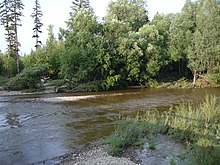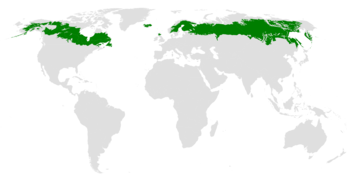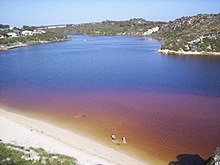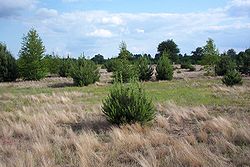Ecology/Biological community
<< Chapter 3 | Chapter 4 | Chapter 5 >>
Chapter 4. The Biological Communities
A community or biocoenosis is an assemblage of organisms (species populations) whose composition and aspect is determined by the properties of the environment and by the relations of the organisms to each other (modified from Braatne, 2005). Möbius proposed the term biocoenosis in 1877 in his study of oyster reefs in the North Sea, recognizing that interactions between species in a structurally complex system brought with it a higher level of functional complexity. Shelford defined a community as an "assemblage with unity of taxonomic composition and a relatively uniform appearance (Odum, 1959)." The biotic community, along with the physical or abiotic elements of the environment together constitute the ecosystem- how a community of organisms interact with their environment of Tansley (1935).
Like an "ecosystem," the size or area occupied by a community can vary considerably. Bounded by the distribution of the component species' populations where these overlap, communities produce a uniform species composition. Some species might as well be members of other surrounding (or distant) communities. Like the ecosystem concept discussed in Chapter 5, the community concept is broadly defined as one of nested units: conceptually small units potentially being part of containing larger units. This fact is recognized when ecologists define major communities as those of sufficient size and completeness of organization to be relatively independent of adjoining communities, and minor communities as those more or less dependent on neighboring (or surrounding) assemblages.
Communities show both functional and structural (taxonomic) unity, although some species may be replaceable over time and space so that functionally similar communities can have different species compositions. The community concept emphasizes the idea that organisms live together in an orderly manner; that species distributions are more than simply individuals responding in a similar way to a particular set of physical factors. And, of course, a community has properties or characteristics that are more than the sum of its species populations and unique attributes.
- Read Biocoenosis
Communities and Biomes
[edit | edit source]
In simplest terms, a community is an assemblage of populations living in the same place at the same time, interacting with each other and their environment. According to this definition, there are also various spatial scales that are recognized when describing different types of communities. Spatial scale refers to the size of the organisms that make up the community and can range from very small (i.e., bacteria) to very large (i.e., animals). There are three approaches to spatial ecology: Theoretical Ecology, Metapopulation Ecology, and Landscape Ecology (Hanski 1998). Every community affects another adjacent community, i.e. communities intergrade continuously. Read Metapopulation.
Examples of different spatial scales in communities:
- 1. A forest - made up of trees, plants, and animals
- 2. A single tree - made up of a community of insects and flora
- 3. A termite gut - made up of a community of protozoa, bacteria, and archaea
- Read Communitiy (Ecology).
Emergent properties of communities include stability, response and resilience to invasion and drought, and bioremediation. (Read Bioremediation)
Terrestrial Biomes
[edit | edit source]The earth contains many different geographical areas that contain similar climatic conditions. As a result of natural selection, many comparable ecosystems, "biomes", have developed in these areas. A biome is a community on a global scale, and is usually defined by temperature, precipitation, and by the types of plants and animals that inhabit it. Generally, biome classification is determined by the climate and geography of an area. Each biome consists of communities that have adapted to the different climate and environment inside the biome. Specifically, there are special vegetation adaptations as well as physical and behavioral adaptions made by animals in order to accommodate the environment.

Several biomes have been identified and include tropical forest, temperate forest, taiga, grassland, chaparral, desert, tundra, and aquatic environments. Tropical forests are characterized by high precipitation (around 75–200 cm of rainfall a year) and high temperatures. In contrast, the coniferous forests of the taigas get just 30–84 cm of precipitation per year and are exposed to average temperatures of -60 Celsius degrees in the winter. Chaparrals also play host to extreme temperatures and low precipitation (15–40 cm of per year) while grasslands average 25–70 cm of rain per year and have temperatures similar to those of temperate forest and deserts. Deserts and tundras are both very dry biomes (less than 30 cm of precipitation per year), but differ widely in their average temperature ranges. While there are clearly a wide variety of biomes on Earth, they are not all equally represented in terms of land mass.

Taigas are the largest terrestrial biome covering the Earth's surface. Located in the Northern Hemisphere, just below the tundras, they cover 11% of the land mass in the Northern Hemisphere and make up 27% of the Earth's total forest. In fact, the biggest forest in the world is the Siberian taiga.
Conifers that make up taigas exhibit needles rather than leaves as a specialized adaptation for the taiga biome. The needles have less surface area for better water retention and a wax covering with sunken stomata to help reduce water loss and to protect the conifers from freezing weather. The dark green color of the conifer needles helps absorb energy from the sun to induce photosynthesis for survival. Conifers also display an inverted funnel shape to help shed the enormous amounts of snow load. The long cold winters and the short summers make it hard for plants and animals to survive and the taiga biome is consequently less diverse than others. The acidic soil of the taiga regions also affects the vegetation and the animals that feed on those plants.

The survival and land mass coverage of the taigas is threatened by many factors. Since the woody bark of conifer trees is easily burned, fires, natural or man-made, pose a major threat to the taigas. Also, logging and clear cutting for pasture land diminishes the size of the taigas in certain areas. The province of Manitoba has signed away 40% of its productive taiga for cutting; an area equal to the size of North Dakota. In addition, Alberta, Canada is allowing massive deforestation in the next sixty years. The loss of a considerable portion of the taiga is major concern, not only because of the subsequent loss of biodiversity and oxygen production, but also because of the "greenhouse effect". The grasslands are also affected by disturbances. Belcher et al. 1989[1] studied 25 km2 of mixed-grass prairie in Manitoba Canada. The study showed that native prairie was affected by disturbances such as roads, trails, and plowed fireguards. These disturbances expose mineral soil allowing for infestations of leafy spurge which significantly declines the abundance of the dominant native grass species. Leafy spurge poses a threat to potention rangeland, and the conservation of native vegetation.
Aquatic Communities
[edit | edit source]There are three types of aquatic communities that occur in nature: marine, freshwater, and estuaries.
Marine communities are supported by water of relatively high salinity and are composed of organisms that are able to survive such high-salt conditions. The tropical coral reef is an example of a marine community that is usually found in shallow, tropical marine waters in latitudes ranging from 30°N to 30°S. On average, the growth of these communities is limited to depths of less than 100 feet and water temperatures greater than 72 °F (22 °C). These growth limiting factors facilitate the formation of limestone, the major structural component of the reefs. The limestone is secreted by living organisms, including Cnidarians, coralline algae, mollusks, echinoderms, and some annelid worms. Cnidarians are the chief contributor to the limestone formation as they secrete an exoskeleton of calcium carbonate.[2]

There are three basic types of coral reefs: Fringing Reef, Barrier Reef, and Atoll. Fringing Reef is continuous with the shore line and is usually exposed during low tide. Barrier Reef is further away from shore and is usually separated from the shore by a lagoon with an island. The Great Barrier Reef, located off the cost of Australia, is the largest known coral reef. Its width varies between 10 and 90 miles along its 120-mile length. Atoll is a type of reef that allows some passage out to sea and surrounds a lagoon that does not have an island.
The reefs accommodate organisms of both mobile and non-mobile species. Lobsters, crabs, squid, reef sharks, and many different types of fish and sea cucumbers feed off of the reefs. Different types of algae also inhabit the reefs and serve as a food source for predators.
While the coral reef is an important marine community, many factors are negatively affecting its survival. In fact, as Jackson (1997) points out, coral reef communities have most likely been degraded long before the study of ecology was made relevant in the 1920s. ^ Today, the hulls and anchors of ships associated with the fishing industry are causing damage to the reefs and high demand from the jewelry industry is decreasing the size of the reefs considerably. Coastal development, water pollution and tourism also pose a threat to the success of the coral reef communities. Jackson proposes the need for large scale reef protection efforts with "extreme" political, economic, and social implications if there is to be any hope of reef conservation.^
[3] [http://www.reefbase.org/key_topics/reeffisheries.as}

In contrast to marine communities, freshwater communities are supported by water of relatively low salt concentration and are composed of organisms that would most likely not survive in high salinity conditions. Freshwater communities include rivers, lakes, streams, and ponds.
An estuary represents a community that is supported by freshwater and saltwater. Estuaries occupy a coastal location, with an open connection to the sea and some type of freshwater flow (i.e., rivers and streams). Therefore, they are affected by the constraints of both types of environments, creating many small biological niches and accommodating high diversity.

Due to the variable nature of the salinity in estuaries, there are many factors that must be taken into account during estuary classification. Circulation patterns, tidal range, freshwater input, dominant habitat types, etc., are all examples of potentials for estuary variation. Therefore, estuaries are typically classified by regions (i.e. northeastern United States, southeastern United States). However, as Roman et al. point out, each estuary is capable of exhibiting unique characteristics due to the complex nature of the geomorphology of a specific area. ^ Even though regional classifications are generally acceptable, it is important to remember that there are always exceptions to the rule.
Aquatic Ecosystems
[edit | edit source]Aquatic ecosystems are comprised of two main types: freshwater ecosystems and marine ecosystems. The main driving force of life in these ecosystems is plant growth, from which food chains begin. Plants require four components to grow. They are water, energy in the form of solar radiation (sunlight), inorganic carbon (either carbon dioxide or bicarbonate ions), and minerals/nutrients. Something that we may take for granted is that many of these ecosystems are downstream from humans. However, this fact has not gone unnoticed in the ecosystems. Frissell points out that a number of well monitored species have been detrimentally effected from being downstream of humans. Frissell argues this is due to the fact that we need to view changes to aquatic ecosystems differently than terrestrial ecosystems. Events such as fire and windstorms dramatically effect terrestrial ecosystems, while they have little effect on aquatic systems. At the same time things such as flooding and accelerated erosion are limited in terrestrial ecosystems, but very important in aquatic systems. This is the context in which aquatic ecosystems should be viewed. [4]
Freshwater Ecosystems
[edit | edit source]The study of freshwater ecosystems is termed limnology. They can be divided into two broad categories: lentic ecosystems, which are contained in basins, and lotic ecosystems, which are flowing water systems. Glaciers are one cause of lentic environments, where retreating glaciers leave behind basins. The flowing water of lotic systems is responsible for about 6 to 30 times the productivity in primary producers compared to primary producers in standing water (Nelson and Scott 1962).
Saltwater Ecosystems
[edit | edit source]Saltwater ecosystem structures are dictated by temperature, salinity, currents, waves, and tides. The most productive areas of the sea are coral reefs and coastal waters. Freshwater rivers eventually empty into the ocean and terrestrial ecosystems meet the edge of the sea. In certain areas, specifically Australia, there have been increases in salinity in freshwater regions. This has been shown to be a major factor driving natural selection in this region; only the most tolerant organisms are able to survive and reproduce. Unfortunately, it appears that the salinity of these regions will continue to increase. However, the effects of the salinity changes on the ecosystem are unknown and remain to be seen in those areas.[5]
Limnology
[edit | edit source]Limnology (from Greek: Λίμνη limne, "lake"; and λόγος, logos, "knowledge") is the study of inland waters (both fresh and saline) and their biological, physical, chemical, geological, and hydrological aspects. This includes the study of natural and man-made lakes, ponds, rivers, streams, wetlands, and groundwaters. When studying the dynamics of an ecosystem, limnology involves variables such as pH, temperature, depth, and dissolved oxygen profiles of the body of water. Productivity of the system is tested using a transparency test with a Secchi disk, or by analyzing species diversity and abundance.
François-Alphonse Forel (1841–1912) established the field with his studies of Lake Geneva, the largest freshwater lake in Europe. Limnology is closely related to Hydrobiology,the science of underwater life, which applies the principles and methods of physics, chemistry, geology, and geography to ecological problems. Much of modern hydrobiology can be viewed as a sub-discipline of ecology, but the sphere of hydrobiology includes taxonomy, economic biology, industrial biology, morphology, physiology, etc. The study of life in inland waters can be divided into lotic system ecology (flowing waters) and lentic system ecology (still waters).
One area of current research is eutrophication, which focuses on biotic interactions in plankton assemblage. This branch of hydrobiology involves microbial loops, water blooms, phosphorus load, and lake turnover. Another concern of limnology is the acidification of mountain lakes. Long-term studies are being carried out to monitor changes in the ionic composition of river, lake, and reservoir water as a result of acid rain and fertilization. Another goal of current research is the elucidation of the basic environmental functions of the ecosystem in reservoirs, which are important for water quality management and water supply.

Many populations of fish are declining in certain habitats due to environmental changes and recreational fishing. In response, fish hatcheries breed fish in a predator-free, unlimited resource environment before releasing them into a natural habitat, also known as stocking. A study by Power (1994)^ investigated predation by sauger and walleye on paddlefish that were being stocked in Lake Sakakawea. Predators at three different sites along the lake were sacrificed, and 73% had ingested at least one paddlefish. All of the ingested paddlefish still intact were only 36-52% of adult size. These findings suggest that paddlefish are being stocked in the lake before they are large enough to avoid such predation. Another issue with stocking is that the progeny are sometimes genetically inferior to those that are born in a natural habitat. The downfall to raising fish in such an environment is that there is no competition and no "survival of the fittest."
Microorganisms have a huge influence on limnology. They are largely responsible for nitrogen balance in lakes, decomposition of water humus in bogs, annual cycling of iron, and oxidation of sulfur. Kuznetsov (1968)^ studied this complex cycling by incubating reservoirs and using radioactive isotopes of carbon, nitrogen, iron, and sulfur to monitor what form they were in and at what rate turnover occurred. Microorganisms establish an elaborate cycle to maintain chemical stability that allows a variety of aquatic life to flourish.
Succession
[edit | edit source]The concept of succession was first clearly put forth by Clements (1916). The classical use of the term involves three fundamental concepts (after Mitsch and Gosselink, 1986):
- vegetation occurs in recognizable communities;
- community change through time results from the biota present modifying the environment (changes are autogenic);
- changes are linear and directed towards a climax ecosystem (Odum, 1971).
Succession is the predictable and orderly changes in the composition or structure of an ecological community. It's a colonization of a disturbed area that eventually leads to an increase in species diversity. Succession is divided into two stages- (1) Primary Succession and (2) Secondary Succession.

Primary succession deals with the recolonization of bare ground. The primary succession has r-selected organisms-- species that can survive at high disturbance areas and are fast growing organisms. There are several factors that can cause disturbance- (1) people, (2) diseases, (3) fire, (4) precipitation/floods, (5) wind/hurricanes/tornadoes, (6) temperature extremes (like freezing or extreme heat), and (7) volcanoes. In other words, the communities that are in early succession will be dominated by fast-growing, well-dispersed species. The other stage of succession (as succession moves forward) will be replaced by more competitive species Wikipedia:en:Ecological succession/Succession. A good example of primary succession is the ecological response to the Mount St. Helens eruption in 1980. Bishop et al. 2005[6] describes that a primary succession landscape like Mount St. Helens may teach us fundamental mechanisms that describe the formation and function of ecological communities. The use and understanding of these mechanisms may lead to the restoration of devastated landscapes.
The other stage of succession is secondary succession which is the recolonization of partially cleared areas (this occurs after primary succession). Eventually, secondary succession/colonization leads to mature communities called climax communities which are stable communities. The secondary succession communities have k-selected organisms--organisms that use the limiting resource the best and therefore can out-compete other individuals. The secondary succession may include a seral community--an intermediate stage found in ecological succession in an ecosystem that advances towards its climax community.
- Read Succession
References
[edit | edit source]- [7] Bishop, John, G. 2005. "Causes and consequences of herbivory on prairie lupine (Lupinus lepidus) in early primary succession" Ecological Responses to the 1980 Eruption of Mount St. Helens 1:151-161
- [8] Belcher, W. Joyce 1989. "Leafy spurge and the species composition of a mixed-grass prairie" Journal of Range Management 42(2): 172-175
- Braatne, Jeffrey H. 2005. Stream Ecology class website at the University of Idaho).
- Clements, E. E. 1916. Plant Succession. Carnegie Inst. of Washington, Pub. 242: 512 pp.
- [9] Frissell, Christopher A.; Bayles, David. 1996. "Ecosystem Management and the Conservation of Aquatic Biodiversity and Ecological Integrity" Water Resources Bulletin 32(2):229-240
- [10] Jackson, J.B.C. 1997. "Reefs since Columbus." Coral Reefs. 16: S23-S32.
- [11] Kuznetsov, S. I. 1968. “Recent Studies on the Role of Microorganisms in the Cycling of Substances in Lakes.” Limnology and Oceanography. 13, 211–224.
- Mitsch, William J., and James G. Gosselink. 1986. Wetlands, New York: Van Nostrand Reinhold. 539 pp.
- [12] Nielsen, D.L.; Brock M.A.; Rees, G.N; Baldwin D.S. 2003. "Effects of increasing salinity on freshwater ecosystems in Australia" Australian Journal of Botany 51:655-665
- Odum, E. P. 1959. Fundamentals of ecology. W. B. Saunders Co., Philadelphia and London. 546 p.
- Odum, E. P. 1971. Fundamentals of ecology. 3rd edition. W. B. Saunders Co., Philadelphia and London. 544 pp.
- [13] Power, G. J. 1994. “Walleye and Sauger Predation on Paddlefish in Lake Sakakawea, North Dakota.” North Dakota Journal of Fisheries Management. 14, 226–227.
- [14] Roman, Charles T, et al. 2000. “Estuaries of the Northeastern United States: Habitat and Land Use Signatures.” Estuaries. 23(6): 743–764.
- Tansley, A. G. 1935. The use and abuse of vegetational concepts and terms. Ecology, 16(3): 284–307.